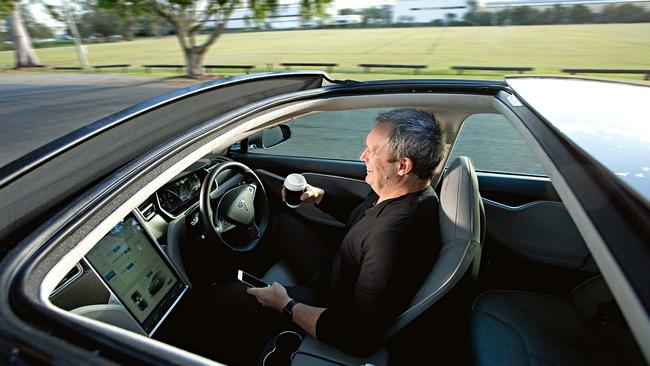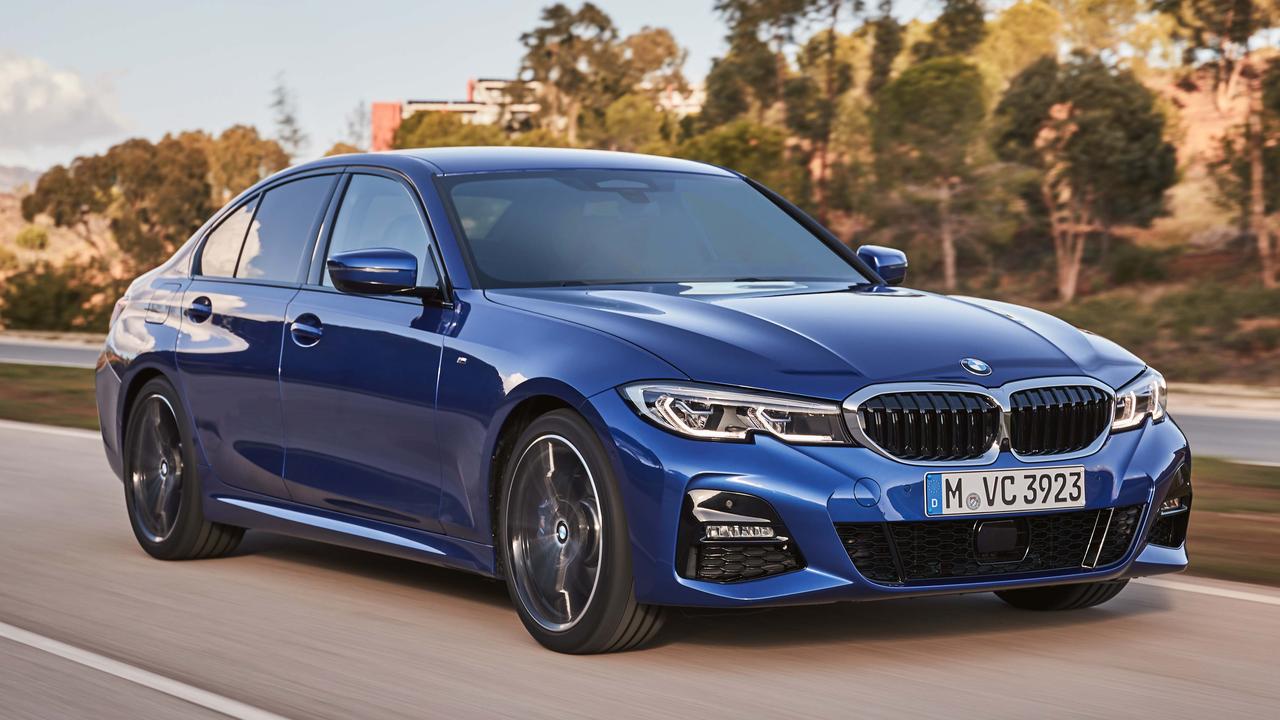Roll on robot
Join us in this $100k Tesla, one of the first in the nation with Autopilot, for a hands-free drive through Brisbane traffic.

On a midweek afternoon I’m standing on a busy street in inner-city Brisbane, watching traffic. The clock has just struck three, which means that school pick-ups are coinciding with tradies knocking off for the day from nearby construction sites. In a few minutes I’m passed by dust-flecked utes, sedans with baby boosters in the backseat, four-wheel drives, council buses, vans, motorcycles and hatchbacks. In control of each vehicle is a regular human driver - a fallible, distractionprone entity with a limited field of vision.
It could be any day, anywhere in Australia. But then a sleek grey car glides up to where I’m standing.
If I wasn’t expecting it, I wouldn’t have heard it: the Tesla Model S is practically silent, powered by electricity stored in lithium-ion batteries rather than petrol. Its best trick, however, is hidden within the array of computer systems behind the dashboard, and it’s a feature that’s likely to change the nature of personal transport. In contrast to the other vehicles that have passed me this afternoon, this one has the ability to drive itself.
The car’s owner, Jon Atherton, loves Tesla’s Autopilot feature. He recently engaged it at 4am one Saturday, soon after leaving his inner Brisbane home and merging onto the near-empty M1 motorway. For 75km or so, all the way to the Gold Coast, the car drove itself and its human cargo - Atherton and his 16-year old daughter, Minna - to swimming practice. From the driver’s seat he recorded a short video of the trip showing the car holding firm in a central lane and taking a slight corner at a steady speed of 103km/h. The steering wheel turns without Atherton’s touch. The footage, posted on Facebook, is at once eerie, futuristic and hair-raising.
This technological shift towards automation presents a raft of challenging and complex issues for state and federal regulators. Adding to the complexity is the fact that Atherton woke up one morning late last year to find that the software system had automatically updated itself. Suddenly, Autopilot became a standard feature for tens of thousands of Tesla Model S owners across the world. How can state and federal governments regulate that kind of overnight innovation?

I hop in the Tesla with Atherton that midweek afternoon and as we head north towards the airport he engages Autopilot with a subtle doublepull of the cruise control stalk located behind the wheel. In that moment, the trip shifts
from test drive to joyride. It’s not until I witness his car driving itself, with my own fallible optical sensors, that the possibilities of this technology unlock in my mind.
As we pass through the AirportLink tunnel at 80km/h, Atherton says, “It’s doing a pretty good job of keeping us safe, and balancing the distance between all of the things around us.” Just as a human would, I note. “The thing is, this computer is not distracted, or distractible,” he replies, looking me in the eye, hands off the wheel. “Even if somebody comes screaming up beside us, it’ll try to keep us out of trouble. If you started to show me a message on your phone, I could get distracted and veer off the road. But the car’s less likely to do that.” When Autopilot was first released, Atherton - a tanned, 50-year-old mobile app developer and entrepreneur - compared the feeling of handing over control to the software to relinquishing the driver’s seat to a learner driver. “I didn’t feel 100 per cent comfortable with something else being in charge,” he says. His anxiety soon passed when he saw how well the technology worked.
That 4am trip to the Gold Coast in January is a perfect example. “It drove the whole way, and I didn’t touch the steering wheel or change the speed,” he says. “A couple of times cars pulled in front of us and it just slowed down, sat in the middle lane and cruised along.” At this stage, Tesla’s Autopilot cannot wholly replace a human driver: it requires well-painted line markings to locate the lane, its cameras can’t tell the difference between green and red traffic lights and it won’t obey stop signs - that’s still up to the human behind the wheel. Tesla advises against total hands-free driving and if a driver removes their hands, a display near the dash shows the message: “Please keep your hands on the wheel”.
But essentially, the responsibility lies with the driver as to whether or not they do so.
Currently, Australian road rules do not spell out the fact that at least one hand must be on the wheel at all times in order to be in control of the vehicle. So, operating Autopilot without gripping the wheel is the sort of thing a police officer might decide to write a ticket for if they happened to catch a Tesla owner in the act. The matter has not yet been tested in an Australian court of law.

Whether hands are on or off the wheel, the car’s cameras are forever scanning the location of surrounding vehicles and will take evasive action if the software detects an imminent collision.
Atherton narrowly avoids three such incidents on our short afternoon journey. He is obeying the speed limit and keeping to his lane, but other drivers fail to perform shoulder checks and almost merge into the car, which cost him about $US100,000 to import. His was one of the first Model S vehicles to arrive in Queensland in February 2015; Tesla won’t reveal how many have been imported to Australia, instead stating that more than 100,000 exist globally.
“In five years’ time there are going to be millions of these in existence,” says Atherton. “Volvo and Mercedes are building some of these features in. Ultimately, I think it means you’re a lot safer. There’s no question about that.” Last year, 1209 people died on Australian roads. The oldest was aged 97; the youngest had not yet turned one. Of the total deaths, 560 were drivers, 249 were passengers, and 202 were motorcyclists; the remainder were either pedestrians or cyclists. Human error is the major contributing factor - a momentary lapse of concentration, failure to give way or a pair of eyes trained on a mobile phone rather than the road ahead can extinguish a life in a moment.
It’s a number that should be horrifying: 1209 deaths a year means 23 a week, or more than three a day. But it is a statistic that we as a society tacitly accept. The road toll has decreased over time, thanks to compulsory safety measures such as seatbelts. But we still pilot heavy masses of steel and plastic at speeds in excess of 100km/h - much faster than the human body was designed to move. All we have to do is press our right foot to the floor. There has to be a smarter, safer way to drive. One answer is to remove fallible human decision-making as much as possible.
South Australia’s premier Jay Weatherill is a big supporter of this new technology. He rode in a self-driving Volvo at 70km/h during the southern hemisphere’s first such trial in November, saying at the time: “The saddest job of a police officer is to attend a family and tell them a member of the family has died. If they could see a technology that is reducing the road toll, I’m sure they will be urging government to adopt it as early as they can.” South Australia was the first jurisdiction in the country to introduce specific legislation to facilitate on-road automated vehicle trials and it remains the only state to have done so. In April, the NSW Government’s Staysafe Committee launched an inquiry into the technology’s potential impact on road safety in the state, noting that it appeared to be “nothing less than ground-breaking”.
A necessary path to my adulthood was learning to drive my father’s Holden Rodeo ute on trafficfree backstreets, bunny-hopping the manual transmission until I got the hang of balancing the clutch. Today, driving remains an adolescent rite of passage and a way to put distance between yourself and your parents. At 28, I’m not a parent, but who knows whether I’ll be in the same position to teach my own children to drive a few years down the track? Maybe they’ll just tap an app to summon a nearby driverless vehicle to spirit them home, hands free, having never learnt a skill that many of us take for granted.
As my joyride with Atherton showed, such technology is already operating on Australian roads in small numbers and regulators are scrambling to conduct research before finalising reports that lead to legislative change. In this sphere, the National Transport Commission has taken the lead: since starting work on this project in November 2015 - about the same time that Australian Tesla owners woke up to find Autopilot installed in their cars - the NTC has published an initial issues paper and is taking submissions until early July.
Marcus Burke is the NTC’s project manager on this matter. “It’s a topic that everyone is very interested in,” he says on the phone from Melbourne.
Road safety is driving government interest in this area; Burke cites the well-known fact in the auto industry that about 90 per cent of crashes are
caused by human error. The other major benefit of automated vehicles is mobility: driverless technology will mean greater freedom for disabled and vision-impaired people and allow Australia’s ageing population to stay independent longer.
As an Australia-wide body, the NTC is committed to streamlining regulatory changes across the states and territories. While it is focused on the regulatory frameworks, the operational aspects are being investigated by Austroads, another national body. It is considering different views on vehicle registration and driver licensing, as well as the design and maintenance of road networks to support self-driving vehicles, including line marking, signage and road geometry. There’s also the matter of installing or upgrading digital infrastructure and communications coverage.
“If it’s an automated vehicle, and it could hand back the driving task to a human operator, will that human driver need a higher level of training than they do today?” ponders Stuart Ballingall, Melbourne-based program director of cooperative and automated systems at Austroads. “It’s quite a safety-critical task they’re taking back, at short notice. Or if the human isn’t in control, do they even need a driver’s licence? Are we going to allow people who are below a certain age, or intoxicated, to travel in a fully automated vehicle?
What are the implications of that?” The NRMA, the largest member-driven motoring organisation in the country, is highly supportive of autonomous vehicle technology, despite the reluctance of some of its membership base. “Like any new technology, there is clearly some community uncertainty and concern,” NRMA Group CEO Rohan Lund tells me, “and it is beholden on decision-makers to address these concerns as the technology becomes more prevalent.
“The step to full autonomy in motor vehicles is gradual,” Lund adds. “Concerns will fade as people become used to ceding more and more driving control to their car, just as we have done today with the introduction of adaptive cruise control and automatic emergency braking. What we cannot afford to do is allow moral panic to hold the nation back. When the steam locomotive was first introduced, there were real fears that the human body could not sustain travelling at 50 miles per hour. Now we safely travel at more than 10 times that speed without the blink of an eye.” In this field, several overlapping descriptors have emerged in recent years and they are used interchangeably by manufacturers and consumers:
self-driving and semi-autonomous cars are stepping stones to the eventual introduction of truly driverless vehicles. This is a long-term vision, but it’s not too difficult to imagine a day when cars come without steering wheels so that humans can’t regain control even if they want to.

Each weekday morning, David Pickett spends about 90 minutes driving 65km from his home in Camden, southwest of Sydney, to the Volvo office in Macquarie Park on the north shore - and each weekday afternoon he makes the return trip.
“That’s a three-hour commute - on a good day. It’s getting worse - one of the joys of living in Sydney,” says the 53-year-old with a rueful chuckle.
Pickett, Volvo Australia’s grey-haired technical and engineering manager, is behind the wheel of a XC90 sports utility vehicle, whose base model begins at $90,000 plus on-road costs. We’re travelling on a busy motorway north of Brisbane the day before he’s due to give a presentation at the Queensland Transport and Infrastructure Conference.
While he drives, he shows me how Volvo’s semiautonomous driving feature works: it’s called IntelliSafe Autopilot and, like Tesla’s feature, its software locks onto the vehicle in front and follows its speed, while keeping to its lane and diligently monitoring nearby vehicles on a graphical interface within the driver’s field of vision.
Pickett does his best to ensure that, where possible, his work vehicle is equipped with the autopilot feature. “My priority is, have I got this system in the car, so that when I’m stuck in
bumperto-bumper traffic, the car’s sorting itself out? If so, I’ll turn the system on the instant I get out of the driveway and I’ll use it the whole way to and from work. I find it takes some of the stress out. Nobody enjoys driving at 15 to 20km/h.
“Our customers have said they want a steering wheel; they want to drive the car,” says Pickett, as we travel at 80km/h with autopilot engaged.
“They may not want to drive it all the time and, usually, driving bumper-to-bumper is the time you’d rather be doing something else. The sooner we can start getting cars that can steer while we’re stuck in traffic, the better.” Selling the benefits of autonomous vehicle technology to sceptical consumers is almost as important as writing the computer code for it.
Slick marketing and male models abound on the manufacturer’s website, which seeks to sooth anxieties about who’ll be responsible if the car crashes while you’re immersed in a book or snoozing.
“Volvo will accept full liability whenever one of our cars is in autonomous mode,” reads a quote attributed to the company’s president and CEO, Hakan Samuelsson. “We are one of the first car makers in the world to make such a promise.” Like Tesla, Volvo is cagey about sharing its Australian sales figures, preferring to state that more than one million Volvos fitted with this technology are in use across the world, while currently about 40 per cent of all XC90s sold on the Australian market are fitted with the driver support package, which costs an additional $4000.
The week after our meeting and the tech demo, I do some calculations on Pickett’s commute.
Three hours a day means 15 hours per week.
Across a year, allowing for holidays, that’s about 720 hours spent simply driving to and from the office. “That’s rather depressing when you add it all up,” he admits. I pose a hypothetical: if autonomous vehicle technology increases to the point where he could reclaim those 720 hours each year, how might he choose to spend them?
“The trip to work would be handy; I could plan out the day ahead and get a handle on what the day will bring,” he says. “On the way home I could just relax and watch the news, or finish off that email that might have kept me in the office for longer, causing me to get home late and miss dinner with my family.” So, drive hands-free and spend more free time at home? Roll on, robot technology.



